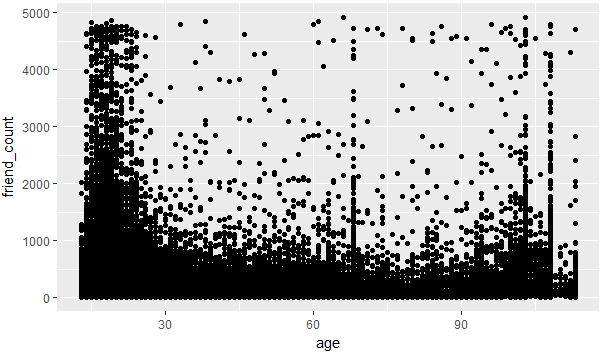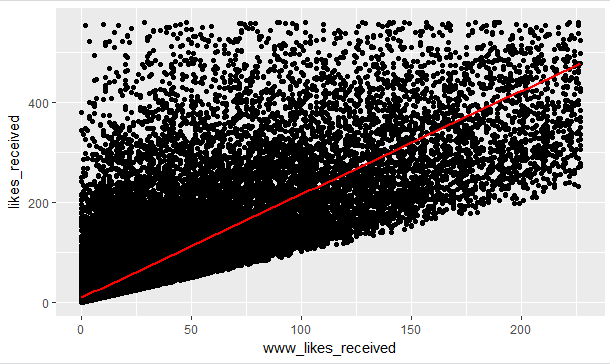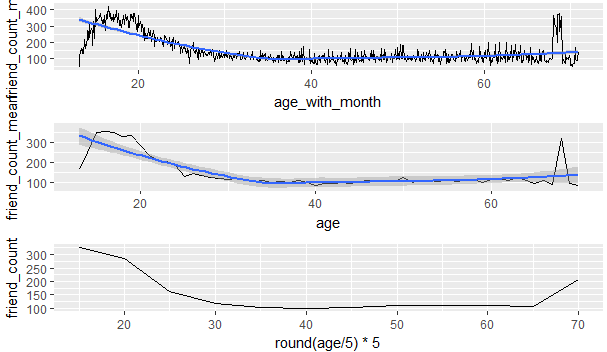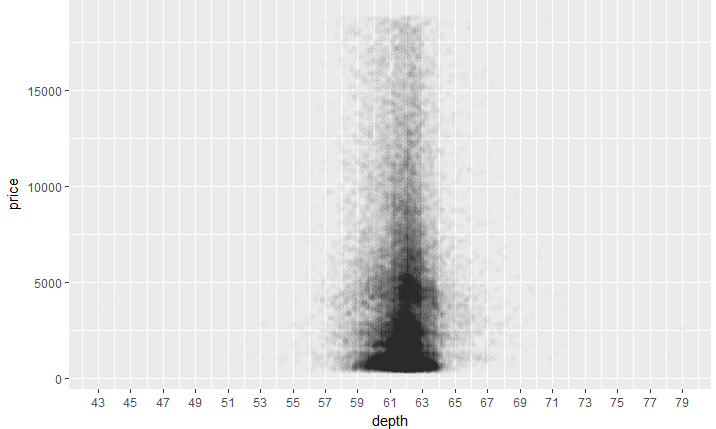R语言-探索两个变量
目的:
通过探索文件pseudo_facebook.tsv数据来学会两个变量的分析流程
知识点:
1.ggplot语法
2.如何做散点图
3.如何优化散点图
4.条件均值
5.变量的相关性
6.子集散点图
7.平滑化
简介:
如果在探索单一变量时,使用直方图来表示该值和整体的关系,那么在探索两个变量的时候,使用散点图会更适合来探索两个变量之间的关系
案例分析:
1.根据年龄和好友数作出散点图
#导入ggplot2绘图包
library(ggplot2)
setwd('D:/Udacity/数据分析进阶/R')
#加载数据文件
pf <- read.csv('pseudo_facebook.tsv',sep='\t')
#使用qplot语法作出散点图
qplot(x=age,y=friend_count,data=pf)
#使用ggplot语法作出散点图,此处使用ggplot作图语法上更清晰
ggplot(aes(x=age,y=friend_count),data=pf)+ geom_point()

图 2-1
2.过渡绘制,因为图2-1有大部分的点都重叠,不太好区分哪个年龄和好友数的关系,所以使用alpha和geom_jitter来进行调整
#geom_jitter消除重合的点
#alpha=1/20表示20个值算1个点
#xlim(13,90)表示x轴的取值从13,90
ggplot(aes(x=age,y=friend_count),data=pf)+
geom_jitter(alpha=1/20)+
xlim(13,90)

图 2-2
3.coord_trans函数的用法,可以给坐标轴上应用函数,使其的可视化效果更好
#给y轴的好友数开根号,使其可视化效果更好
ggplot(aes(x=age,y=friend_count),data=pf)+
geom_point(alpha=1/20)+
xlim(13,90)+
coord_trans(y="sqrt")

图2-3
4.条件均值,根据字段进行分组然后分组进行统计出新的DataFrame
#1.导入dplyr包
#2.使用group_by对年龄字段进行分组
#3.使用summarise统计出平均值和中位数
#4.再使用arrange进行排序
library('dplyr')
pf.fc_by_age <- pf %>%
group_by(age) %>%
summarise(friend_count_mean=mean(friend_count),
friend_count_media = median(friend_count),
n=n()) %>%
arrange(age)
5.将该数据和原始数据进行迭加,根据图形,我们可以得出一个趋势,从13岁-26岁好友数在增加,从26开始慢慢的好友数开始下降
#1.通过限制x,y的值,做出年龄和好友数的散点图
#2.做出中位值的渐近线
#3.做出0.9的渐近线
#4.做出0.5的渐近线
#5.做出0.1的渐近线
ggplot(aes(x=age,y=friend_count),data=pf)+
geom_point(alpha=1/10,
position = position_jitter(h=0),
color='orange')+
coord_cartesian(xlim = c(13,90),ylim = c(0,1000))+
geom_line(stat = 'summary',fun.y=mean)+
geom_line(stat = 'summary',fun.y=quantile,fun.args=list(probs=.9),
linetype=2,color='blue')+
geom_line(stat='summary',fun.y=quantile,fun.args=list(probs=.5),
color='green')+
geom_line(stat = 'summary',fun.y=quantile,fun.args=list(probs=.1),
color='blue',linetype=2)

图2-4
6.计算相关性
#使用cor.test函数来进行计算,在实际中可以对数据集进行划分
#pearson表示两个变量之间的关联强度的参数,越接近1关联性越强
with(pf,cor.test(age,friend_count,method = 'pearson'))
with(subset(pf,age<=70),cor.test(age,friend_count,method = 'pearson')
7.强相关参数,通过做出www_likes_received和likes_received的散点图来判断两个变量的关联程度,从图中看出两个值的关联性很大
#使用quantile来过限定一些极端值
#通过xlim和ylim实现过滤
#同时增加一条渐近线来查看整体的值
ggplot(aes(x=www_likes_received,y=likes_received),data=pf)+
geom_point()+
xlim(0,quantile(pf$www_likes_received,0.95))+
ylim(0,quantile(pf$likes_received,0.95))+
geom_smooth(method = 'lm',color='red')

图2-5
8.通过计算月平均年龄,平均年龄和年龄分布来做出三个有关年龄和好友数关系的折线图
从该图中我们可以发现p1的细节最多,p2展现的是每个年龄段不同的好友数量,p3展示的是年龄和好友数的大体趋势
#
library(gridExtra)
pf$age_with_month <- pf$age + (12-pf$dob_month)/12
pf.fc_by_age_months <- pf %>%
group_by(age_with_months) %>%
summarise(friend_count_mean = mean(friend_count),
friend_count_median = median(friend_count),
n=n()) %>%
arrange(age_with_months)
p1 <- ggplot(aes(x=age_with_month,y=friend_count_mean),
data=subset(pf.fc_by_age_months,age_with_month<71))+
geom_line()+
geom_smooth()
p2 <- ggplot(aes(x=age,y=friend_count_mean),
data=subset(pf.fc_by_age,age<71))+
geom_line()+
geom_smooth()
p3 <- ggplot(aes(x=round(age/5)*5,y=friend_count),
data=subset(pf,age<71))+
geom_line(stat = 'summary',fun.y=mean) grid.arrange(p1,p2,p3,ncol=1)

习题:钻石数据集分析
1.价格与x的关系
ggplot(aes(x=x,y=price),data=diamonds)+
geom_point()

2.价格和x的相关性
with(diamonds,cor.test(price,x,method = 'pearson'))
with(diamonds,cor.test(price,y,method = 'pearson'))
with(diamonds,cor.test(price,z,method = 'pearson'))
3.价格和深度的关系
ggplot(aes(x=depth,y=price),data=diamonds)+
geom_point()

4.价格和深度图像的调整
ggplot(aes(x=depth,y=price),data=diamonds)+
geom_point(alpha=1/100)+
scale_x_continuous(breaks = seq(43,79,2))

5.价格和深度的相关性
with(diamonds,cor.test(price,depth,method = 'pearson'))
6.价格和克拉
ggplot(aes(x=carat,y=price),data=diamonds)+
geom_point()+
scale_x_continuous(limits = c(0,quantile(diamonds$carat,0.99)))

7.价格和体积
volume <- diamonds$x * diamonds$y * diamonds$z
ggplot(aes(x=volume,y=price),data=diamonds)+
geom_point()

8.子集相关特性
diamonds$volume <- with(diamonds,x*y*z)
sub_data <- subset(diamonds,volume < 800 & volume >0)
cor.test(sub_data$volume,sub_data$price)
9.调整,价格与体积
ggplot(aes(x=price,y=volume),data=diamonds)+
geom_point()+
geom_smooth()

10.平均价格,净度
library(dplyr)
diamondsByClarity <- diamonds %>%
group_by(clarity) %>%
summarise(mean_price = mean(as.numeric(price)),
median_price = median(as.numeric(price)),
min_price = min(as.numeric(price)),
max_price = max(as.numeric(price)),
n= n()) %>%
arrange(clarity)
11.平均价格柱状图(探索每种净度和颜色的价格柱状图)
library(dplyr)
library(gridExtra)
diamonds_by_clarity <- group_by(diamonds, clarity)
diamonds_mp_by_clarity <- summarise(diamonds_by_clarity, mean_price = mean(price)) diamonds_by_color <- group_by(diamonds, color)
diamonds_mp_by_color <- summarise(diamonds_by_color, mean_price = mean(price)) p1 <- ggplot(aes(x=clarity,y=mean_price),data=diamonds_mp_by_clarity)+
geom_bar(stat = "identity") p2 <- ggplot(aes(x=color,y=mean_price),
data=diamonds_mp_by_color)+
geom_bar(stat = "identity") grid.arrange(p1,p2,ncol=1)

R语言-探索两个变量的更多相关文章
- R语言-探索多个变量
目的: 通过探索文件pseudo_facebook.tsv数据来学会多个变量的分析流程 通过探索diamonds数据集来探索多个变量 通过酸奶数据集探索多变量数据 知识点: 散点图 dplyr汇总数据 ...
- R语言中两个数组(或向量)的外积怎样计算
所谓数组(或向量)a和b的外积,指的是a的每个元素和b的每个元素搭配在一起相乘得到的新元素.当然运算规则也可自己定义.外积运算符为 %o%(注意:百分号中间的字母是小写的字母o).比如: > a ...
- c语言交换两个变量的值
有两个变量a 和b,想要交换它们的值 int a,b; 能不能这样操作呢? b=a; a=b; 不能啊,这样操作的意思是把a的值放到b中,然后b中的值已经被覆盖掉了,已经不是b原来的那个值了,所以是没 ...
- R语言基本操作函数(1)变量的基本操作
1.变量变换 as.array(x),as.data.frame(x),as.numeric(x),as.logical(x),as.complex(x),as.character(x) ...
- R语言里面的循环变量
for (i in 1:10) { print("Hello world") } 以上这条命令执行完之后,变量i会被保存下来!并且,i的值将是10. 程序中有多处循环的时候要非常注 ...
- R语言实现两文件对应行列字符替换(解决正负链统一的问题)
假设存在文件file1.xlsx,其内容如下: 存在文件file2.xlsx,其内容如下: 现在我想从第七列开始,将file2所有的字符替换成file1一样的,即第七.八.九.十列不需要改变,因为fi ...
- 【R语言入门】R语言中的变量与基本数据类型
说明 在前一篇中,我们介绍了 R 语言和 R Studio 的安装,并简单的介绍了一个示例,接下来让我们由浅入深的学习 R 语言的相关知识. 本篇将主要介绍 R 语言的基本操作.变量和几种基本数据类型 ...
- R语言快速入门
R语言是针对统计分析和数据科学的功能全面的开源语言,R的官方网址:http://www.r-project.org/ 在Windows环境下安装R是很方便的 R语言的两种运行模式:交互模式和批处理模 ...
- R语言
什么是R语言编程? R语言是一种用于统计分析和为此目的创建图形的编程语言.不是数据类型,它具有用于计算的数据对象.它用于数据挖掘,回归分析,概率估计等领域,使用其中可用的许多软件包. R语言中的不同数 ...
随机推荐
- 透过一道面试题来探探JavaScript中执行上下文和变量对象的底
在做面试题之前,我们先搞清楚两个概念 执行上下文(execution context) 变量对象(variable object) 执行上下文 我们都知道JavaScript的作用域一共分三种 全局作 ...
- Vijos P1785 同学排序【模拟】
同学排序 描述 现有m位同学,第1位同学为1号,第2位同学为2号,依次第m位同学为m号.要求双号的学生站出来,然后余下的重新组合,组合完后,再次让双号的学生站出来,重复n次,问这时有多少同学出来站着? ...
- Saving James Bond(dijk)
题目连接:http://acm.hdu.edu.cn/showproblem.php?pid=1245 Saving James Bond Time Limit: 6000/3000 MS (Java ...
- 找出单链表中倒数第K个元素
- c++(递归和堆栈)
看过我前面博客的朋友都清楚,函数调用主要依靠ebp和esp的堆栈互动来实现的.那么递归呢,最主要的特色就是函数自己调用自己.如果一个函数调用的是自己本身,那么这个函数就是递归函数. 我们可以看一下普通 ...
- angular2 表单验证
模版式表单 (1) angular遇到form自动接管,不想自动接管,添加ngNoForm,当标签为div时,但想被表单接管,添加ngForm; (2) ngForm可以被模版本地变量引用,以便在模版 ...
- Jfinal——实践出真知
什么是Jfinal? JFinal 是基于 Java 语言的极速 WEB + ORM 框架,其核心设计目标是开发迅速.代码量少.学习简单.功能强大.轻量级.易扩展.Restful.在拥有Java语言所 ...
- DTD约束
DTD约束 一,导入DTD方式 二,DTD语法 2)DTD语法 约束标签 <!ELEMENT 元素名称类别>或<!ELEMENT 元素名称(元素内容)> 类别: 空标签: ...
- tp路由+伪静态+去掉index.php
浏览:10536 发布日期:2013/10/08 分类:技术分享 关键字: 路由 伪静态 去掉index.php 之前一个网友说能不能达到这样的效果,www.olcms.com/news/id.htm ...
- UILabel的顶对齐解决方法
对于有多行文字的UILabel而言,需要设置UILabel的numberoflines属性,此属性默认是1,也就是只显示一行,多余的会以尾部,中间的方式进行截断,具体要看你的初始设置. 在这里可以将其 ...
